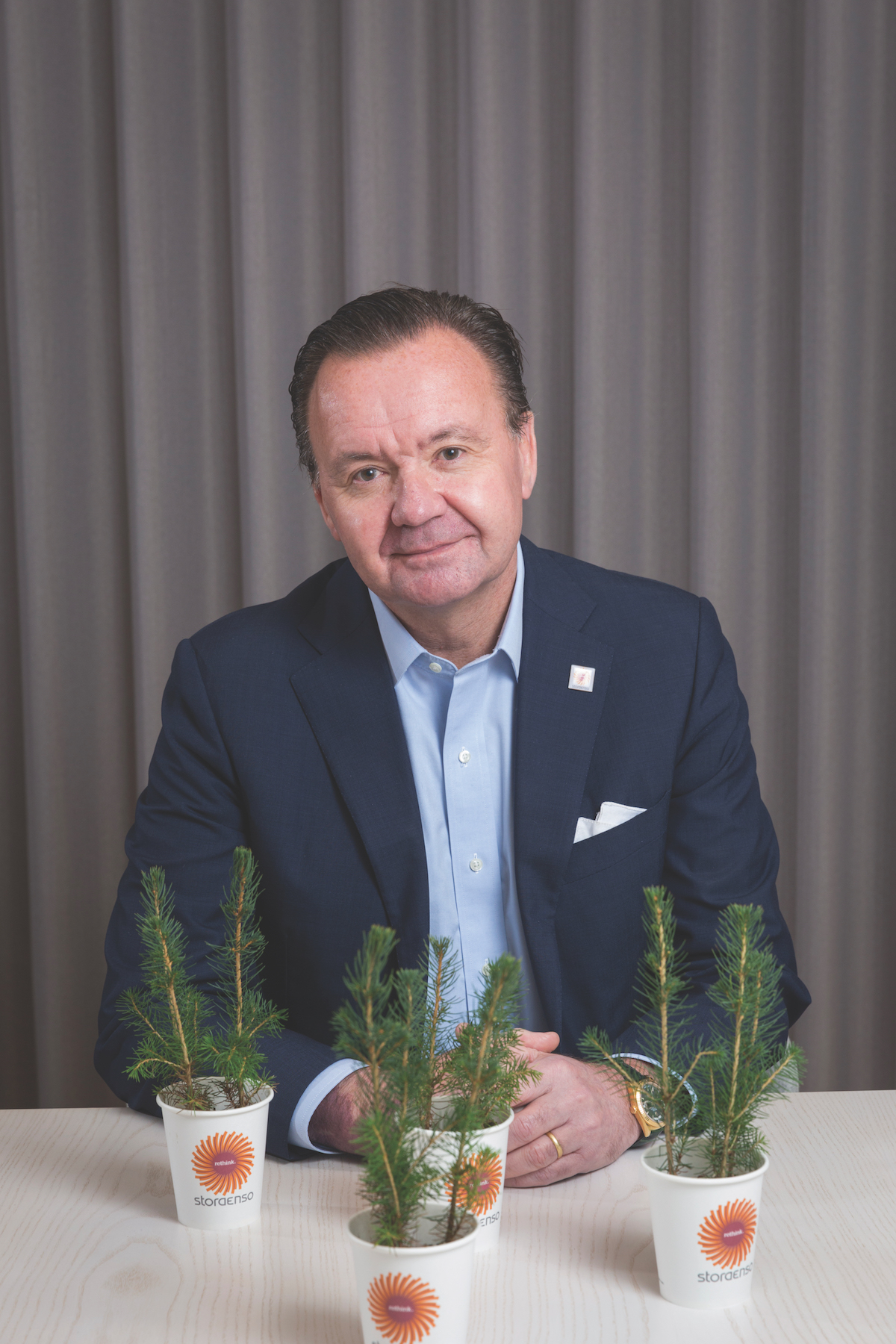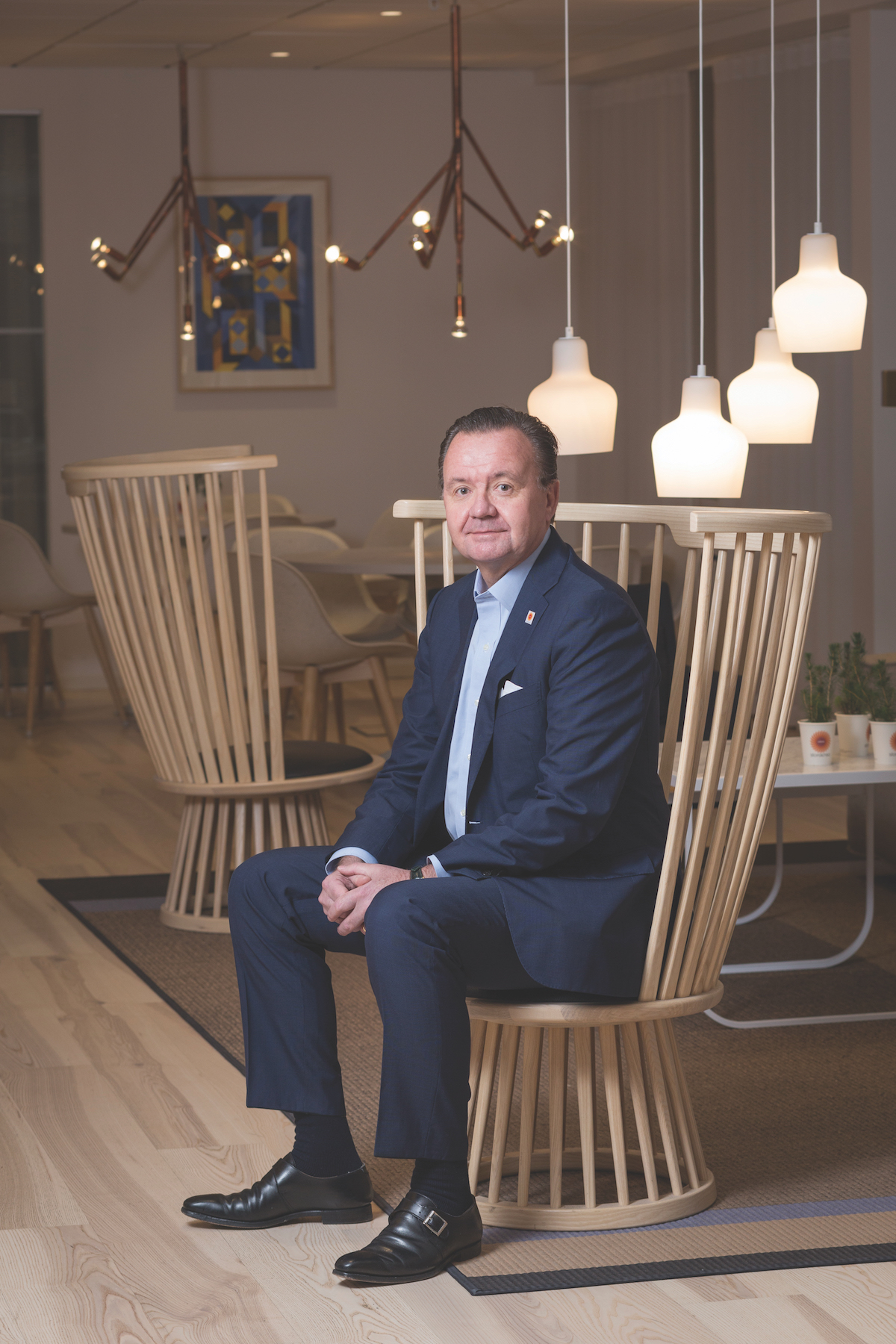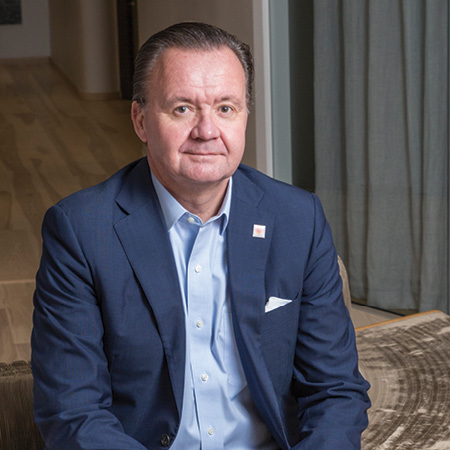“Everything that is made with fossil-based materials today can be made from a tree tomorrow.”
As company messages go, they don’t get much more compelling than Stora Enso’s. Having transitioned from a traditional packaging company to a global leader in renewable packaging solutions, the Nordic business with a social conscience is changing the way we look at — and use — wood.
“There are basically a number of megatrends that are facing every single company today: everything from growing populations to digitisation. We have a changing lifestyle, not just in the Western world but also in emerging markets. The middle class is growing. There is a greater eco-awareness among our consumers, and we also have the big issue of global warming. All of these things are focusing on making sure that we use the resources that we have on this planet more efficiently,” explains Karl-Henrik Sundström, the company’s CEO since 2014.
“We are heading into a new phase which is centred on growth. Our current focus is innovation, sales and customers.” – Karl-Henrik Sundström

He continues: “We are fortunate that our industry has renewable raw material that can not only be reused, but is renewable in a real sense. With wood, we are sitting on a huge advantage, and that’s what Stora Enso is going to explore further to grow the business.”
Traditionally, only 50% of the wood sent into the pulp mill is utilised. This is known as cellulose. Stora Enso’s biomaterials division is devoting much energy and resources into extracting even more from the wood’s raw material in order to offer “marketable products other than pulp.” The results so far offer hope that a more climate-friendly industry is possible.
“The other 50%, what is called lignin and hemicellulose, is usually just burned for energy,” he continues. “It is, however, possible to extract the lignin as well as C5 and C6 sugars, the basic building blocks for creating alternatives to fossil-based materials.”
The company’s Sunila Mill in Finland is the first lignin-extraction plant in the world, and the material produced is seen as a non-toxic alternative to the fossil-based phenols used in resins and adhesives, particularly for the construction industry. “It’s basically green glue,” enthuses Karl-Henrik. “Lignin can also be applied in carbon fibres which can be used in, for example, the automotive industry,” he adds.
Other environmentally friendly innovations derived from the pulp biorefining process include crude sulphate turpentine (CST), a biochemical with uses in the chemical, food and cosmetics industries, and crude tall oil (CTO), from which rosin derives.
Having formed in 1998 as a result of the merger between Swedish mining and forestry products company STORA and Finnish forestry products company Enso Oyj, this marks a completely new focus for a company whose heritage, which dates back to the thirteenth century, is steeped in paper production.
“Between 2006 and the second quarter of 2016, our paper sales dropped from 70 per cent to less than 33 per cent. In terms of profit, it has gone from comprising over 60 per cent of the total profit to less than 20 per cent today,” he says.
“We have probably closed down some 30 per cent of our paper assets because people are buying less and less paper. Paper will always be there, but it will be less relevant in the future and that means today we are a totally different company. We are heading into a new phase which is centred on growth. Our current focus is innovation, sales and customers,” he says.
As proof of this new direction, Karl-Henrik cites innovative research and development centres that have sprung up in Stockholm and Helsinki, a sales academy which offers training programs to sales managers and market area directors in the more than 35 countries the company has a presence in, and a focus on building a number of new consumer-friendly applications, such as intelligent packaging.

As its paper arm structurally declines, the company’s other four divisions, namely packaging, consumer board, wood products, and the aforementioned biomaterials, “have been growing 3–4 per cent for the last six quarters,” he says.
In 2015, Stora Enso reported sales of €10 billion. The packaging and wood divisions were responsible for the majority of this revenue. The company’s renewable, fibre-based packaging solutions are appreciated across an array of industries, from electronics to pharmaceuticals to cosmetics. Its strongest presence can be felt, however, in the food and drink sector: one in three beverage cartons in the world today is produced using materials made by Stora Enso. “We are 10 times as big as our nearest competitor in Europe,” Karl-Henrik says, before adding: “We are currently launching quite a number of new products across our packaging businesses.”
“If you have a partner that is very innovative and is also a leader in sustainability, then they can encourage you to work in a different way.” – Karl-Henrik Sundström
Karl-Henrik believes communication is key to Stora Enso’s business. The research and insights firm Opticom International Research has recognised Stora Enso as the owner of the most valuable cartonboard brands in Europe.
With the rise of online shopping, the company foresees an increased demand for renewable packaging and, with it, an opportunity to incorporate features such as barcodes and near-field communication capabilities to ensure consumer attention is captured from the moment the delivery is received.
According to Karl-Henrik, Stora Enso was “the first company to launch intelligent packaging and the first to set up an innovation centre dedicated to packaging.”
Significant profit has also been generated from its successful wood division. “We are Europe’s biggest supplier of wood-based construction material,” Karl-Henrik says. With a focus on the base material at the core of its operation, the division champions both the environmental and lifestyle benefits associated with wood as a structural base. Its best-selling Cross Laminated Timber (CLT) and Laminated Veneer Lumber (LVL) solutions offer a modern take on the most traditional of building materials, with high fire-safety standards, insulation, soundproofing capabilities, and strength providing persuasive selling points.
A conscious effort to reduce its carbon footprint runs through every process at Stora Enso. “We are almost totally free of carbon dioxide in our production, and are basically fossil-fuel-free in our production as well,” says Karl-Henrik. The lignin produced in Finland’s Sunila Mill, for example, has helped the mill reduce its own carbon dioxide emissions by 27,000 tonnes a year. He concedes, however, that there are still many challenges to be overcome in this regard, especially in inbound and outbound logistics. “We use trains where we can, but we are still reliant on local trucks, especially on the inbound logistics,” he says.
Under Karl-Henrik’s tenure, the company has placed a spotlight on improving efficiency across its sales and operations planning procedures. “We are implementing uniform processes across all our divisions,” he explains. Lead times and delivery times are two such areas. In order to guarantee world-class manufacturing in its factories around the globe, the company “benchmarks most units produced on a number of measures every month, such as relative improvement against the previous period in terms of working capital, safety and fixed and variable costs,” he explains. “We have also centralised our purchasing department and have fixed criteria when choosing our suppliers.”
Suppliers hoping to work with the company must be aligned in corporate and social values. “We want them to be innovative, competitive, offer quality and be a leader in sustainability,” says Karl-Henrik.
An annual Suppliers Day allows Stora Enso the opportunity to “share with our suppliers some of our challenges and the areas where we need support.
“We encourage our suppliers to think outside the box because, if you have a partner that is very innovative and is also a leader in sustainability, then they can encourage you to work in a different way,” he says.
Karl-Henrik elaborates further: “You can return to your people with these insights, and, if you have people who are willing to change their way of working to do things differently, to challenge the existing status quo, that gives you an edge. The more brains you have working on the same issue, the better you get.”
At the heart of any company is its people, and the story is no different at Stora Enso. “One area that is very important for us, and that we are devoting much time and energy to, is employee motivation. We are spending a lot of time on training our employees,” he explains. “We have a number of programs covering everything from graduate training to internal management development.”
As part of its commitment to “rethink to renew”, the company’s Pathbuilders leadership development program — run in conjunction with the IMD Business School in Lausanne, Switzerland — addresses critical business challenges. All employees are encouraged to apply, and successful candidates work together with colleagues from across the entire global organisation to develop and implement innovative business ideas.
The effort is paying off. “Every year, we measure employee satisfaction. It’s getting to very high levels — I would say above benchmark,” he shares.
Top marks are also being achieved in customer satisfaction measures. “We are obviously focusing on ensuring that our offering is better than the competition’s, by having better relationships and close collaborations with our customers,” he adds. “I believe we have among the best net promoter scores in the business.”
Certain innovations have the potential to transform the way we think and, by exploring new possibilities from one of humankind’s oldest materials, it feels like Stora Enso is on the path to achieving this. Karl-Henrik agrees that it’s an exciting time to be leading the company. “Innovation, processes, people and customers are what make me tick. When you get all of
these four together, you create something that is incredible: to be able to push to become a renewable materials company.”

